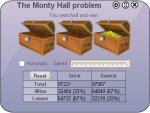About widgets
Let me start by saying that on a personal level, I do not like widgets. I like the idea of web pages being used (as they have for many years - see web-mails for example) as an application. I like the fact that they can be a little more powerful than Web pages, storing information, allowing me to install them and keep them on my computer without needing an Internet connection. I really like the idea that they can be used to develop graphical applications very quickly so that they work on multiple platforms and devices, without needing to know anything more than basic Web technologies (that is the real power of widgets). However, I dislike the lack of integration with either my browser, or my operating system.
Widgets defy several simple, basic rules. Application windows should be able to resize fluidly, so the user can put them where they want them. They should have chrome that can be dragged on any side to resize them, if that is how the user's desktop environment (DTE) works. Applications should be able to maximise on demand - nothing irritates me more than a dialog or settings window that has disabled the maximise button. When maximised, the close button should be in the right place, so the user does not accidentally close another application when they meant to close the current one. They should also be able to minimise. The taskbar button (if the DTE has one) should have the appropriate menus to control the window.
Application windows should have a title bar to make them identifiable, if that is what the DTE uses. They should be dragable only by that title bar, if that is normal for the DTE. They should have whatever menu bar is normal for the DTE, with common menus expected there (such as 'File' and 'Help'). They should respond to the same keyboard shortcuts, and mouse (or any other input device) interaction as any native application. This includes any form inputs used by the application, a vital part of the interactive interface. Wherever possible, they should also use real text instead of images, in order to allow assistive devices to read them.
Application windows should be able to look, at least reasonably, like the DTE theme.
Widgets fail at pretty much all these things. If the user could - on demand - make a widget display inside a normal tab inside Opera, and they would then behave like a normal Web page, all these problems would be solved. If the user wanted them to run outside of the main Opera window, they could detatch the tab (right click on an Opera tab now, and try it - you can put it back using the windows panel), or they could run it as widgets currently run if they prefer that.
With that cleared up, I have been playing with them a little. Mostly I get irritated with them. Very occasionally I find a truly useful one - although in every case, it might as well just be a normal Web page. But widgets have that cool air about them, and sometimes it is nice to have them running in their own little window where they can be kept visibly running, but out of the way.
My widgets
 The Monty Hall problem
The Monty Hall problem
Version; 1.1.1
Amazing but true, past events can predictably affect the outcome of what appears to be a simple 50/50 choice. This puzzle has famously and publically displayed lack of understanding of mathematical probabilities, of novices and experts alike. If you have trouble getting your head around it, let this widget be the proof of the puzzle.
Features
- Manual mode - try making a choice for yourself.
- Automatic mode with adjustable speed - let the widget try the puzzle for you a few thousand times.
- Compact mode - so you can keep it running in the corner of your screen.
- Maximised mode - double click the title bar or Ctrl/Alt/Shift/Cmd+click the compacting button.
- Minimise - Ctrl/Alt/Shift/Cmd+click the close button (it's an ugly hack - please do not complain about the way it works).
- Keeps your 'score' and widget size when closing, so you can continue where you left off.
- Can also be run as a Web page.